Imbolc Valentine Moon
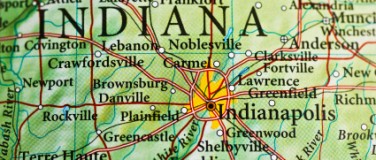 Woke thinking about the subtitle to the book Strangers in Their Own Land: Anger and Mourning on the Right. I realized I knew this one from personal experience.
Woke thinking about the subtitle to the book Strangers in Their Own Land: Anger and Mourning on the Right. I realized I knew this one from personal experience.
In 1956 my family, then Mary, myself, Mom and Dad lived at 311 E. Monroe Street. I was nine. Diane Bailey lived next door, the Kildow kids and the Meyers kids lived about a block away as did Candace. The Carver boy, whose name I can’t recall, lived at the bottom of the hill, Ronnie Huffman lived a block back toward Lincoln.
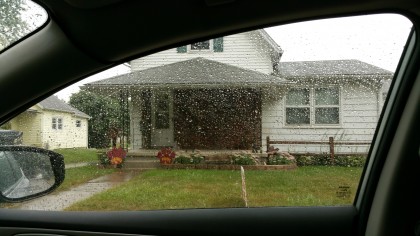
These were all modest homes, not Baltic Avenue, but maybe Tennessee, Virginia. Ours had an oil burning stove in the middle of the second room on the ground floor, a grate above it allowed the air to rise to two small bedrooms upstairs. A smallish living room and a kitchen completed the downstairs. In the living room, unusual for this time period, sat a small black and white television, a gift from the owner of the newspaper, The Times-Tribune, for which my Dad was editor.
Summer days and nights found all of us kids out, playing with each other, coming home at supper time or after dark. We had secret forts in the field, empty ground about two blocks away, a baseball diamond in the Carver’s side yard, a hill down which we rode bicycles and sleds, often putting up ramps for jumps. Once it got dark we’d play hide and go seek or kick the can. Sometimes we’d throw rocks up in the air to watch bats swoop down after them. It was not an unusual childhood, not for those times.
We knew each other well. It was hardly bucolic though. Diane pulled my pants down in front of my friends, so embarrassing to me that I can still feel the flush now 60 years later. There were fist fights and shunning, too. But mostly we got along, making up our lives as we engaged in what now needs a term, free play.
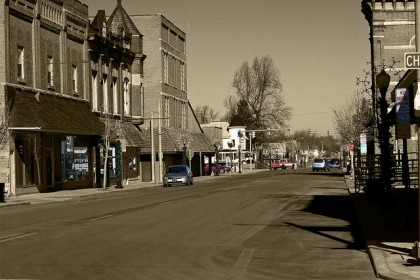
Harrison Street, Alexandria’s main street, ran north and south for maybe 3 miles, from one end of town to the other. Roughly in the middle it blossomed into a retail area. There were grocery stores, Kroger’s and Cox’s, across the street from each other at the beginning, from the north, of the retail portion of Harrison. Cox’s was locally owned. In high school I worked there as a bag boy and a stocker. Eventually, Kroger’s left, but Cox’s remained.
Going across the block from Cox’s on the same, west side, was a Rexall drugstore, Danner’s five and dime, then Murphy’s five and dime across the alley. On the east side, across from the five and ten cent stores was Broyles, a nice furniture store, then Guilkey’s shoe repair, a newsstand, Fermen’s women’s clothing store, and finally in that block, Bailey’s drugstore.
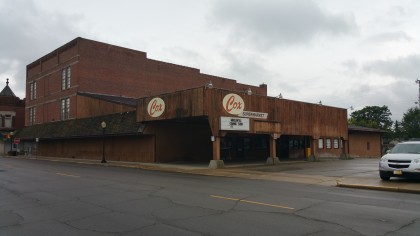 The bakery, a downtown institution where early breakfasts were eaten, donuts and rolls purchased, and midday lunches taken started the next block. Near it was the Yankee Bar, a mystery to all us kids. Baumgartner’s, a men’s clothing store was across the alley from the Yankee. Ralph Mahoney’s shoe store was on the other side of Harrison next to the Town Theater. Insurance offices followed, one run by Thomas Thomas Thomas, whose name was, by my father’s account, given to him so he could have campaign signs that read Tri-Thomas for… Quite a burden for a baby boy. Further on were barber shops, banks, a tailors, a Greyhound bus stop, another bar, a cigar store.
The bakery, a downtown institution where early breakfasts were eaten, donuts and rolls purchased, and midday lunches taken started the next block. Near it was the Yankee Bar, a mystery to all us kids. Baumgartner’s, a men’s clothing store was across the alley from the Yankee. Ralph Mahoney’s shoe store was on the other side of Harrison next to the Town Theater. Insurance offices followed, one run by Thomas Thomas Thomas, whose name was, by my father’s account, given to him so he could have campaign signs that read Tri-Thomas for… Quite a burden for a baby boy. Further on were barber shops, banks, a tailors, a Greyhound bus stop, another bar, a cigar store.
On side streets were the Carnegie Library, a hardware store, a heating and cooling business, the Post Office, Kildow’s paint store, Benefield’s corner grocery, the old high school and the Tiger’s Den, a ramshackle burger joint that served as a gathering place for high schooler’s before the new school was built out the southern edge of town.
Further off was the Times-Tribune building and its big Heidelberg (not Heisenberg) Letter Press, a couple of car dealers, an Elks club, City Hall, a utility building, gas stations, a bowling alley.
Going downtown meant no more than a walk for those who lived as close as Monroe Street, maybe 6 0r 7 blocks. Many of Alexandria’s 5,000 or so citizens lived that close.
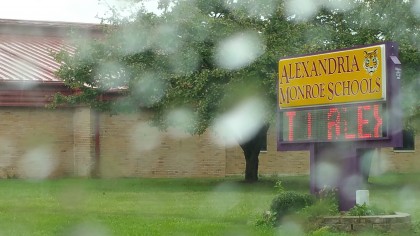 With two feeder schools, Cunningham and Orestes, which went to, I forget, sixth grade or so, all of the kids who used Alexandria’s retail center eventually ended up in the same school. We knew each other, even if our parent’s didn’t. Shopping for groceries or clothes or prescriptions or furniture or shoes brought us into regular contact with one another. Basketball games, especially, were another gathering point. In other words there were many opportunities to run into each other casually, the knitting together stuff of community.
With two feeder schools, Cunningham and Orestes, which went to, I forget, sixth grade or so, all of the kids who used Alexandria’s retail center eventually ended up in the same school. We knew each other, even if our parent’s didn’t. Shopping for groceries or clothes or prescriptions or furniture or shoes brought us into regular contact with one another. Basketball games, especially, were another gathering point. In other words there were many opportunities to run into each other casually, the knitting together stuff of community.
As a result, Alexandria was a community. We didn’t all know each other, but we probably recognized each other from somewhere, maybe getting our shoes repaired at the wonderfully fragrant Guilkey’s or maybe picking up a penicillin prescription for strep throat at Bailey’s or maybe from the produce section at Cox’s. This Alexandria lasted through my high school years. I graduated in 1965.
It didn’t last much longer. In 1974 a combination of the oil shock from the embargo and the influx of foreign cars, following in the vanguard of the venerable Volkswagen Beetle, began to put intense competitive pressure on Detroit. As that competition intensified, the big three: General Motors, Ford and Chrysler began looking for ways to economize, to shorten their supply chains, make cars cheaper, if not better.
Delco Remy and Guide Lamp, maker of alternators and generators and headlights respectively, for General Motors, first cut back, then cut back more and finally, after some years of diminishing employment, closed. While I grew up, those same factories worked three shifts, seven days a week and employed 25,000 people. These were good jobs, union jobs, UAW jobs. They had good salaries, good health benefits and defined pension plans. And, critically, they did not require even a high school education.
That meant the southern diaspora, both black and white, could apply to and find work in these factories. Alexandria filled up with folks from Appalachia, Arkansas, Mississippi, Alabama. They are the same folks Arlie Hochschild wrote about in her book. (see below)
It took awhile, but that vibrant retail center gradually shifted to Dollar Stores and plywood covered store fronts. A small mall built on the outskirts of town siphoned off customers from downtown. Kroger’s closed first and Cox’s closed a year or so ago. Fermen’s and Baumgartner’s are long gone. The bakery closed last year. The Town Theater went dark years ago. The Alex, which I didn’t mention earlier, surprisingly, is still in business. No more bowling alley. No more Kildow’s paint. The old high school was abandoned and demolished. The Johns-Manville plant where I worked as an intern is now an industrial ruin with only concrete slabs and a high chain link fence to recall its once vital presence.
There was the time, now past, when folks pulled their drapes and snuck out of town, usually back south somewhere, embarrassed that they could no longer meet their mortgage payments.
Anger and mourning in the wake of this slow going creative destruction of my hometown mirrors that of the Louisiana folks in Hochschild’s research. These were folks who worked hard, who followed the American dream from their homes in the south to a place where good jobs were. Then, slowly, the dream broke apart in wispy fragments, turning from dream to nightmare.
Now add to this the idea of line-jumping, folks getting pushed ahead in the struggle for a house, a car, education for the kids. No matter how deserving those folks might be, if you’re a former Alexandrian whose job disappeared, leaving you with no way to provide for your family, you would find resentment hard to fend off.
I mourn the loss of the small town, the community in which I grew up. I’m angry about the corporate decisions that stopped the flow of jobs. I’m angry about the lack of response to the plight of those workers, then and now. This was my home and it got decimated by late twentieth century capitalism.
Community is hard to build and easy to destroy. In that sense I agree with the conservative reaction against those forces that dismantle communities. Where I part company with the conservatives is in their analysis of the source of those forces. I point to Wall Street and banks too big to fail. I point to sclerotic American companies, like GM, that refused to meet their competition with better cars, but instead slashed costs. I point to the refusal of both Democratic and Republican governments to appreciate the pace of economic change and its ravaging effect on persons with a high school education or less. You might even call the effect carnage.
I no longer have the Christian faith many from Alexandria still do. I never subscribed to the flag-waving, gun-toting patriotism typical of many of them, too. I can, however, appreciate, particularly in the context of the economic dislocation they’ve suffered, the anger at the government which did little to nothing to protect them and their families and at those who seem to be getting slotted ahead of them in the struggle to recover. I share their mourning about what we all have lost, not just in Alexandria, of course, but in Pittsburgh, Toledo, Cleveland, Detroit, Chicago and in the many small towns and middle sized towns who depended on steel or cars or plastics or rubber or glass to give them life.
How this all plays out over the next few elections is difficult to estimate or project. There are grievances here that are deep and valid. How we can knit this country back together may be the biggest challenge we’ve faced in my lifetime, dwarfing the Vietnam War, and no less significant than the civil rights movement or the women’s rights movement. Trump is not helping since he seems determined to play to the baser elements of our nature. That means it’s up to the rest of us.
